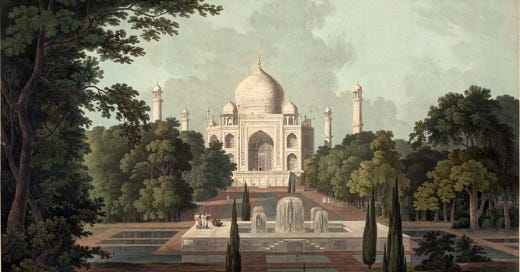The British plan to sell the Taj Mahal.
Starting around 1810 and continuing through the next decade, a British officer named Lt. Joseph Taylor was made incharge of a project seeking to conserve monuments like the Akbar’s Tomb, Agra Fort and the Taj Mahal. What ensued was rampant corruption and use of sub standard materials in the restoration works. For instance, he stole marble from the Agra Fort instead of procuring newer building materials to repair the minarets of the gateway of Akbar’s tomb.
The conservation projects were a failure and started to be a money drain.
In 1828 Lord William Bentinck became the new Governor-General of India. The First Anglo - Burmese War (1824 - 1826) had depleted the coffers of the East India Company. Without money, the company faced the serious risk of losing the mandate it had received from the British crown, which enabled it to conquer and rule India.
In 1830, Lord Bentinck visited the Agra Fort which was in a dilapidated state owning to years of corruption by Lt. Joseph Taylor. Instead of making an effort to restore the monument, Lord Bentinck had the rest of the marble columns and edifice of the Imperial Bath dismantled. Most pieces were sold to raise money for the government, while certain sections were sent to England by Lord Bentinck as a gift to the British monarchy. Some of these stolen marble columns are now proud exhibits in the Victoria and Albert Museum in London.
Having successfully raised money from the sale of marble stolen from Agra Fort, Lord Bentinck naturally assumed that the marble of the Taj would be worth even more.
On July 26, 1831, an advertisement to sell Taj Mahal was published in an English daily of Kolkata. Auction started with the Seths (Bankers) of Mathura and Rajasthan and other English Bidders.
Seth Laxmichand Jain emerged as the highest bidder with a bid of Rs. 2 lakh, . He was a Hindu banker from Mathura who was so fabulously rich that he was known among the British as the Rothschild of India. The figure was deemed too low and a second auction was called for a few months later. This time too, Seth Laxmichand Jain was the highest bidder and The Taj Mahal was finally sold for Rs. 7 lakh. As story has it, when Seth Laxmichand Jain went to take possession of the Taj Mahal, he was chased away by the locals. The descendants of Seth Laxmichand Jain claim he was trying to save the Taj.
Meanwhile the British Parliament and the London Office of the East India Company got wind of the situation. Fearing rebellion from the locals, they immediately ordered Lord Bentinck, the Indian Governor General, to give up this stupid idea.
The auction ended …. but the looting did not ….
In those times, it was a practice of Rich British families to visit decorated Mughal buildings and dig precious stones to be taken back as souvenirs. Even Lord Hastings had many precious stones from Taj Mahal sent to London.
Much later, Lord Curzon, called for an auction on 7th February 1900. Many old paintings and precious carved stones, which included material from Taj Mahal were auctioned off.




